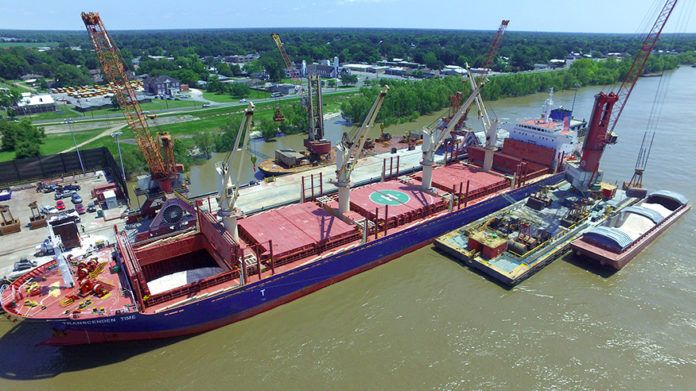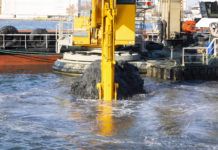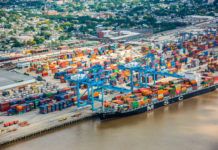The leaders of Louisiana’s deepwater ports are clamoring for deeper, more consistently maintained river channels, and their voices are getting louder. An increase in channel depths, they say, will lead to increased cargo capacities and an ability to handle larger vessels, which in turn will make them more lucrative ports of call.
It’s hard to deny that the state’s ports are major economic catalysts. According to data provided by the Ports Association of Louisiana, about 400,000 jobs and $20 billion in personal earnings are directly attributable to the ports. In the lower Mississippi River alone, more than 500 million tons of cargo are moved on an annual basis, contributing to the state’s ranking among the top tonnage port locations in the country.
Still, the need for a more dependable means of dredging remains a persistent problem, and a lack of funding is the culprit. Both the ports and the U.S. Army Corps of Engineers are largely dependent upon state and federal money, and without it little can be done.
NATION’S NO. 7 PROJECT
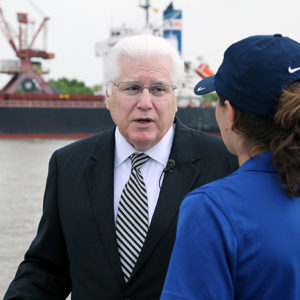
Fortunately, the Corps appears to be making some headway. A proposed plan would deepen the Mississippi River’s main ship navigation channel from 45 to 50 feet between the river’s mouth and Southwest Pass, as well as dredge three “crossings” between New Orleans and the Port of South Louisiana.
So far, the news out of Washington has been encouraging, as the Trump administration has made the $88.9 million project a high priority. The effort to deepen the channel is No. 7 on the administration’s Top 50 infrastructure projects, announced in January.
Marti Lucore, senior project manager at the Corps’ New Orleans District office, says the Mississippi River deepening project was originally proposed decades ago.
“We already have authority to go to a deeper depth, but we haven’t moved on constructing anything in 20 years,” Lucore says. “We have to make sure that it’s economically justified, because we haven’t looked at this since the 1990s. Since so much time has passed, it’s not just a simple update; we must start over. That’s why it’s so comprehensive, to confirm that we’ve got our analysis right.” While the original plan called for maintaining a minimum 50-foot depth from the Gulf to Baton Rouge, recent feasibility studies have shown that the greatest need extends only to the Port of South Louisiana, which occupies 54 miles of riverfront beginning about 17 miles upriver from the Port of New Orleans.
Paul Aucoin, executive director of the Port of South Louisiana, says the deeper channel will open a new world for his port. Aucoin has been pushing for the project, as well as for ongoing funding of routine maintenance dredging. “This whole country needs to be aware of the importance of the mouth of the river and how it has to be dredged to 50 feet every day all day,” Aucoin says. “There are 31 states that depend upon the Mississippi River and those tributaries. Of the 59,000 grain barges that come here, about 40,000 are from the Midwest, and that grain depends upon the mouth of the Mississippi River.”
Aucoin is encouraged by the Trump administration’s commitment to fund the river’s deepening. “If we’ve got a depth restriction at the mouth of the river, and you can only load a vessel down to 41 feet, that’s $1 million a foot that you’ve lost. Not only is it costly; we’re unreliable and they’re going to shop somewhere else.”
Aucoin says this severely impacts Louisiana’s ability to compete. “If you’re sending something out at $22 a ton, but you can’t load the ship fully, suddenly that’s costing you $27 a ton. My goal is to find stand-alone, untouchable funding for the mouth of the river, which will benefit this entire country.”
AN ECONOMIC BOON
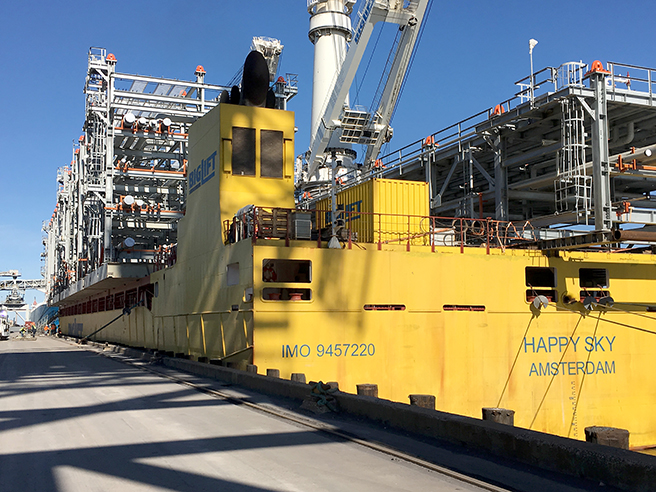
Brandy Christian, new president and CEO at the Port of New Orleans, says the trend toward larger vessels means ports and their various funding authorities must remain competitive, adding that the economic benefits of deepening the channel to 50 feet are irrefutable. “Based on Corps data, it would create $11.5 billion in U.S. production, 17,000 new jobs and $849 million in income.”
Unlike other ports in Louisiana, the Port of New Orleans operates its own dredge to maintain consistent river depths near its facilities. Made necessary by sedimentation buildup in the shipping births, the dredging maintains a depth of 45 feet so that ships have a “clean” approach. “The flexibility in water depth is extremely important,” Christian adds. “As you know, ships are getting larger. The river stage is extremely important for business as well as attracting larger ships.”
While it’s not likely New Orleans, or any Louisiana port, will be able to support the larger New Panamax ships—those are destined for west and east coast ports—New Orleans can receive vessels as large as 9,000 TEUs (a standard maritime industry measurement meaning “Twenty-Foot Equivalent Units”). “That’s the other big piece of this—when you get up into the 8,000 or 9,000 TEU range, you want more flexibility in depth. That enables them to more efficiently load their ship with containers, which obviously is better for their economics,” Christian explains.
Even after funding is received, the Corps’ will need to perform some preliminary work. “We’ve got to make sure there are no pipelines or other obstructions in the way, because there’s thousands of utility pipelines under the river,” Lucore says. “We have to make sure we’ve identified any that need to be relocated to a greater depth.” Fortunately, early indications are that there are few obstructions.
The Corps estimates that maintaining and operating the deeper channel will cost about $21.6 million a year and that the net annual benefit to the U.S. economy will be $96.8 million. In a recent study, the federal agency said the project would result in a national economic benefit-to-cost ratio of about 5.47 to 1. The deepening project could take as long as four years to complete and produce about 18 million cubic yards of sediment, some of which will be used to create wetlands.
THE CALCASIEU SHIP CHANNEL
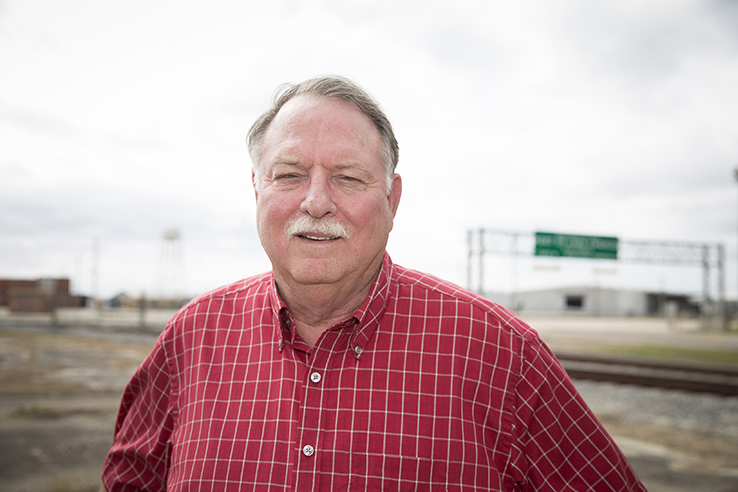
In southwest Louisiana, it’s both channel width and depth that are giving the Port of Lake Charles headaches. Located about 35 miles inland from the Gulf, the port is the 11th busiest in the U.S. and about to get busier. Sixteen of the current announced LNG and industrial projects would be users of the channel; that represents more than $68 billion in capital expenditures.
Port of Lake Charles Executive Director Bill Rase fears dredging issues in the Calcasieu Ship Channel will severely restrict his port’s ability to support the growth. Speaking at the Louisiana Oil & Gas Association’s annual meeting in Lake Charles in March, Rase said a big part of the problem is a lack of available dredge disposal areas.
“The channel needs 97 million cubic yards of disposal capacity for dredged material,” Rase said. However, a 2010 Corps study identified only 5 million cubic yards of available disposal capacity.
“Existing disposal sites must be re-built and new sites added to provide the needed capacity,” he said. “In order for them to pick up the silt and mud that’s in the channel they have to have a place to put it. That is something that the state is required to do, and as sponsors for the state we have to make sure that we have areas that are acceptable.”
Rase estimates the cost to keep the ship channel open in a deep draft capacity will be $79 million over the next 20 years, adding that a reliable source of funding for the channel must be found.
If not, the Calcasieu Ship Channel would not remain a deep draft waterway, resulting in a loss of current and future economic benefits.
He compares the channel to a pipeline. “It’s the channel that gets your product to the rest of the world. The channel’s a very important part of the picture, not only for the local economy, but the state, the nation and the world.
“Today, we’re bringing in 40-foot draft ships and have to get right through the middle of the channel to achieve that,” he adds. “It gets very tight, and we try to prevent that situation, but it does happen.”
Rase credits the skill of the pilots for successfully navigating ships in such tight conditions.
OTHER IMPROVEMENTS
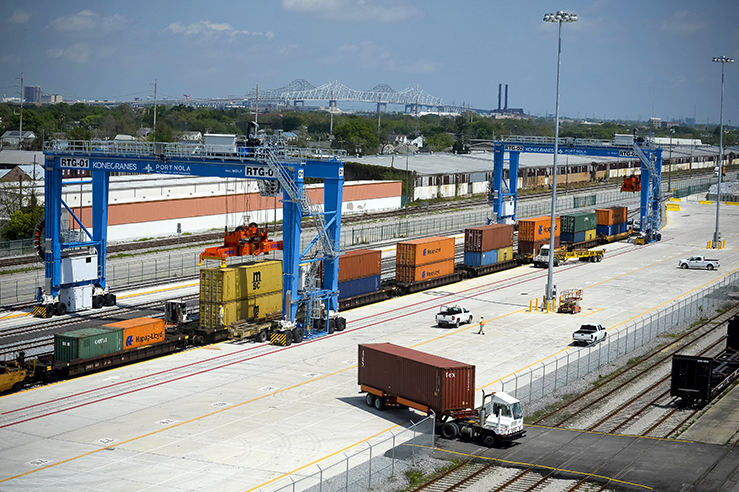
Apart from the need for dredging, there’s plenty of infrastructure development going on at the state’s deep draft ports. One of Christian’s most immediate tasks at the Port of New Orleans will be the continued development of the port’s master plan, Port NOLA 2025, which seeks to identify those projects necessary to meet port needs in the next decade, as determined by market forecasts and demand analysis.
Of recent significance is a $25 million investment in an intermodal rail center at the Napoleon Container Terminal, completed in 2016. “We now offer the capability to move things not only by barge, but by truck and expanded rail,” she says. The port redistributed existing dock facilities to make way for new rail tracks and two new rubber-tired gantry cranes. Additionally, an 18-inch-thick layer of concrete was placed to boost container storage capacity.
The port also installed a refrigerated container racking system. “We’re able to stack the containers so it’s a more efficient use of space and keeps the container contents cold in a consistent way. It has really made a difference in terms of our ability to provide quality service.”
Two of the port’s terminal operators—New Orleans Terminal LLC and Ports America—recently invested in an automated gate system. Using integrated software, the system has resulted in a 25% increase in gate transactions through systematized appointment scheduling.
At the Port of South Louisiana, Aucoin says about $57 million in investment is currently underway, some of which is related to the doubling in size of one of the port’s primary warehouses. Another big project on the horizon is a stand-alone container port.
“We can put containers on grain barges instead of a train or a truck,” he says. “We’ve got 40,000 grain barges going back empty anyway, so they could easily take those containers up to Memphis, St. Louis and Chicago.” The port received a 50%-funded federal grant to conduct a market study to determine the project’s viability.
PORT CAMERON UPDATE
Supporters of the planned $1.5 billion Port Cameron LLC deepwater oil and gas industry-support complex hope it will one day facilitate new industrial development along the Calcasieu Ship Channel through a new “shared facilities” concept.
Port Cameron is centrally located to serve offshore installations in the Gulf and will initially be situated on 500 acres, with another 750 acres available for future expansion. The project also includes about 25,000 linear feet of all-weather roads and two new concrete bridges.
Director of Operations Ted Falgout, who joined the port in 2015 after serving at Port Fourchon for 31 years, says Phase 1 of the project should begin within weeks of receiving the U.S. Army Corps of Engineers’ permit. Evans-Graves Engineers in Baton Rouge is the project’s designer.
“We anticipate moving into construction within three months or so after the permit is issued,” Falgout says. He expects that to happen in 2017.
Port Cameron has partnered with Peterson, a Netherlands-based company proficient in the shared facilities concept, to support planning, development and marketing at the port. A relatively new concept in the Gulf, shared services is expected to generate significant operational savings for port tenants. “Tenants are sharing a dock, space and facilities, thereby not having to pay for it all themselves,” Falgout says. “You’re splitting the overhead of those things. Sharing is the new buzz word—everybody’s talking about it because they want to cut costs.”
While there are currently no long-term lease commitments, Falgout says there is significant interest. “At 33 feet deep, the slips will be considerably deeper than anything that’s available in the energy services industry. This will open opportunities to companies that have been unable to operate or have to go somewhere else to accommodate the drafts for their equipment.”
Situated centrally in the Gulf, Port Cameron’s location provides a strategic advantage.
“One of our greatest assets is being adjacent to the Calcasieu Ship Channel, which opens the opportunity for many kinds of things that occur in the Gulf,” Falgout says. “We’re only 180 miles from Houston, the epicenter of the oil and gas industry, and only 16 miles from the Intracoastal Waterways.”
Port Cameron will be an intermodal facility, “offering an opportunity that over time will cause a paradigm shift in how cargo is moved. It will save fuel and have all the great environmental benefits.”
This article was originally published in the second quarter 2017 edition of 10/12 Industry Report.

